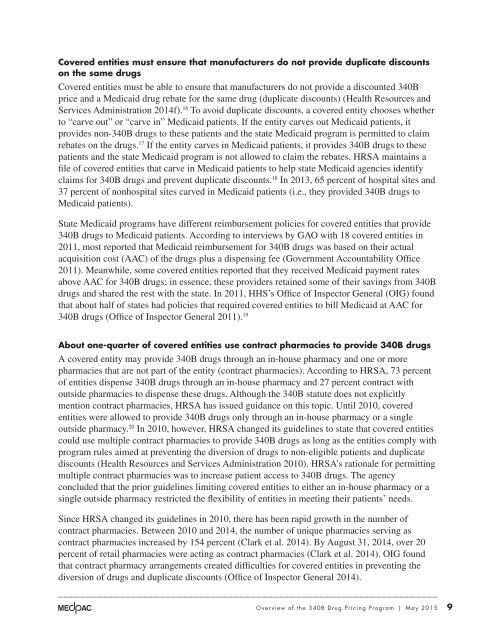Overview of the 340B Drug Pricing Program
1Mmfbin
1Mmfbin
You also want an ePaper? Increase the reach of your titles
YUMPU automatically turns print PDFs into web optimized ePapers that Google loves.
Covered entities must ensure that manufacturers do not provide duplicate discounts<br />
on <strong>the</strong> same drugs<br />
Covered entities must be able to ensure that manufacturers do not provide a discounted <strong>340B</strong><br />
price and a Medicaid drug rebate for <strong>the</strong> same drug (duplicate discounts) (Health Resources and<br />
Services Administration 2014f). 16 To avoid duplicate discounts, a covered entity chooses whe<strong>the</strong>r<br />
to “carve out” or “carve in” Medicaid patients. If <strong>the</strong> entity carves out Medicaid patients, it<br />
provides non-<strong>340B</strong> drugs to <strong>the</strong>se patients and <strong>the</strong> state Medicaid program is permitted to claim<br />
rebates on <strong>the</strong> drugs. 17 If <strong>the</strong> entity carves in Medicaid patients, it provides <strong>340B</strong> drugs to <strong>the</strong>se<br />
patients and <strong>the</strong> state Medicaid program is not allowed to claim <strong>the</strong> rebates. HRSA maintains a<br />
file <strong>of</strong> covered entities that carve in Medicaid patients to help state Medicaid agencies identify<br />
claims for <strong>340B</strong> drugs and prevent duplicate discounts. 18 In 2013, 65 percent <strong>of</strong> hospital sites and<br />
37 percent <strong>of</strong> nonhospital sites carved in Medicaid patients (i.e., <strong>the</strong>y provided <strong>340B</strong> drugs to<br />
Medicaid patients).<br />
State Medicaid programs have different reimbursement policies for covered entities that provide<br />
<strong>340B</strong> drugs to Medicaid patients. According to interviews by GAO with 18 covered entities in<br />
2011, most reported that Medicaid reimbursement for <strong>340B</strong> drugs was based on <strong>the</strong>ir actual<br />
acquisition cost (AAC) <strong>of</strong> <strong>the</strong> drugs plus a dispensing fee (Government Accountability Office<br />
2011). Meanwhile, some covered entities reported that <strong>the</strong>y received Medicaid payment rates<br />
above AAC for <strong>340B</strong> drugs; in essence, <strong>the</strong>se providers retained some <strong>of</strong> <strong>the</strong>ir savings from <strong>340B</strong><br />
drugs and shared <strong>the</strong> rest with <strong>the</strong> state. In 2011, HHS’s Office <strong>of</strong> Inspector General (OIG) found<br />
that about half <strong>of</strong> states had policies that required covered entities to bill Medicaid at AAC for<br />
<strong>340B</strong> drugs (Office <strong>of</strong> Inspector General 2011). 19<br />
About one-quarter <strong>of</strong> covered entities use contract pharmacies to provide <strong>340B</strong> drugs<br />
A covered entity may provide <strong>340B</strong> drugs through an in-house pharmacy and one or more<br />
pharmacies that are not part <strong>of</strong> <strong>the</strong> entity (contract pharmacies). According to HRSA, 73 percent<br />
<strong>of</strong> entities dispense <strong>340B</strong> drugs through an in-house pharmacy and 27 percent contract with<br />
outside pharmacies to dispense <strong>the</strong>se drugs. Although <strong>the</strong> <strong>340B</strong> statute does not explicitly<br />
mention contract pharmacies, HRSA has issued guidance on this topic. Until 2010, covered<br />
entities were allowed to provide <strong>340B</strong> drugs only through an in-house pharmacy or a single<br />
outside pharmacy. 20 In 2010, however, HRSA changed its guidelines to state that covered entities<br />
could use multiple contract pharmacies to provide <strong>340B</strong> drugs as long as <strong>the</strong> entities comply with<br />
program rules aimed at preventing <strong>the</strong> diversion <strong>of</strong> drugs to non-eligible patients and duplicate<br />
discounts (Health Resources and Services Administration 2010). HRSA’s rationale for permitting<br />
multiple contract pharmacies was to increase patient access to <strong>340B</strong> drugs. The agency<br />
concluded that <strong>the</strong> prior guidelines limiting covered entities to ei<strong>the</strong>r an in-house pharmacy or a<br />
single outside pharmacy restricted <strong>the</strong> flexibility <strong>of</strong> entities in meeting <strong>the</strong>ir patients’ needs.<br />
Since HRSA changed its guidelines in 2010, <strong>the</strong>re has been rapid growth in <strong>the</strong> number <strong>of</strong><br />
contract pharmacies. Between 2010 and 2014, <strong>the</strong> number <strong>of</strong> unique pharmacies serving as<br />
contract pharmacies increased by 154 percent (Clark et al. 2014). By August 31, 2014, over 20<br />
percent <strong>of</strong> retail pharmacies were acting as contract pharmacies (Clark et al. 2014). OIG found<br />
that contract pharmacy arrangements created difficulties for covered entities in preventing <strong>the</strong><br />
diversion <strong>of</strong> drugs and duplicate discounts (Office <strong>of</strong> Inspector General 2014).<br />
<strong>Overview</strong> <strong>of</strong> <strong>the</strong> <strong>340B</strong> <strong>Drug</strong> <strong>Pricing</strong> <strong>Program</strong> | May 2015 9


